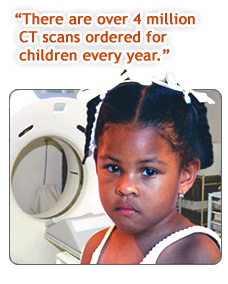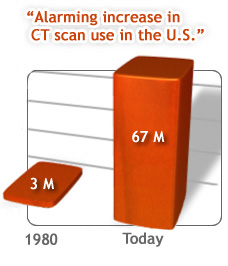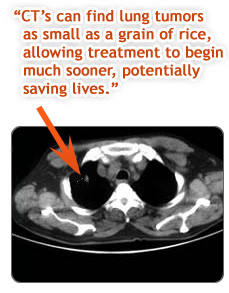  You visit your doctor’s office, complaining of pain in your abdomen. After taking your medical history and a brief examination, your doctor wants to rule out some potentially serious health problems, such as appendicitis. He suggests you have a low-dose radiation test called a computed tomography (CT) scan. Should you be worried about the risks of the test?
A recent study published in the New England Journal of Medicine suggests maybe you should be. The authors used data from Japanese atomic bomb survivors to show that low-dose exposure to radiation, much like you’d receive from CT scans and multiple x-rays, could increase the rate of future cancers in the United States by 2%.
The authors were alarmed over the growing use of CT scans in the U.S. -- from 3 million in 1980 to more than 67 million annually today. Children have at least 4 million CT scans every year.
As many as a third of these tests may be unnecessary.
Why CT?CT scans have tremendous medical value. A one-dimensional standard x-ray can give your doctor some information about your condition, but CT technology opens a three-dimensional window of what’s happening in your body. In this test, a computerized machine scans your body with x-rays, making three-dimensional, cross sectional films of tissues and organs. The test reveals much more detail than single x-rays have provided in the past.
 "Plain x-rays are useful for some things," says Thomas Koshy, MD, a radiologist at upstate New York’s Benedictine Hospital. "But if you need more detail, no other imaging test gives such cross-sectional anatomy of what’s going on inside the patient."
In hospital emergency rooms, doctors order this test for patients with head trauma, where there may be bleeding into the brain. The test gives doctors immediate information about your condition, as opposed to waiting for the results of another useful, but time-consuming, test called magnetic resonance imaging (MRI). CT is also frequently used to diagnose suspected cases of kidney stones and to track the spread of cancer, among other conditions.
Importantly, CT scans have drastically reduced false-positive rates of appendicitis, sparing many people from unnecessary appendectomies. As a result, potentially dangerous exploratory surgeries are rarely done today.
Moreover, CT technology has improved over the years. For example, some of the newer machines can clearly show a blockage forming in a blood vessel as thin as a toothpick. CT can also find lung tumors as small as a grain of rice, allowing treatment to begin much sooner, potentially saving lives.
 The consThe view through this three-dimensional window comes with a price: more radiation exposure. CT scans give you a bigger dose than other tests -- one CT chest scan equals the radiation from about 150 standard chest x-rays. That’s a lot of radiation -- more than twice what a typical person would receive from their environment in a given year. Fact is, having multiple CT scans (or x-rays, for that matter) may increase your risk for some cancers.
One practice that may have more to do with marketing than actual benefit is called "whole-body" CT scanning. Because of its three-dimensional viewing power, this test is purported to be able to find problems like pre-cancerous growths, long before they become dangerous. So far, however, whole-body CT scanning hasn’t proved to be cost-effective or practical for most patients.
What should you do?While low-dose radiation has been shown to affect Japanese atomic bomb survivors over the long-term, the potential cancer risks of CT scans aren’t very clear. "This story may have sold a lot of newspapers, but I have seen no scientific studies that prove CT scans increase cancer," says Koshy.
So… what should you do if your doctor suggests you have one?
First, ask why the test is necessary. A CT scan can be the best test for your health problem. Sometimes, however, it may be better to have an x-ray, an MRI (you receive no radiation), an ultrasound (which can also be used to diagnose an appendicitis and some artery diseases), or no test at all -- especially if there's no emergency. Considering alternatives to CT is especially important if you have heart disease, a case in which you may have multiple CT scans over time, exposing you to more radiation.
Keep track of the number of CT scans you receive. It’s always important to keep good medical records, anyway. Use extra caution if a doctor says your child needs a CT scan. Pregnant women and young women should ask about alternative tests, too. Both children and younger women are at risk from radiation exposure over time. Pregnant women should avoid exposing themselves to radiation whenever possible.
Newer scanning machines have child-appropriate dosage settings. Most radiologists also follow commonly used "ALARA" (As Low As Reasonably Achievable) standards and tailor the dosage to the size of the patient and the area being scanned. For instance, more radiation is needed to see inside the brain than to view an appendix. And kidney stones are highly visible in CT scans, so little radiation is needed.
Still worried? You should always have some questions about any medical test. But don’t be scared away from CT imaging because of potential side effects. Most people who need this test have only a small, long-term risk.
That risk is usually worth the benefit of finding out if you have a harmful health problem.
Editor’s Note: Click here to read more about CT scans in your company’s health & wellness portal.
|